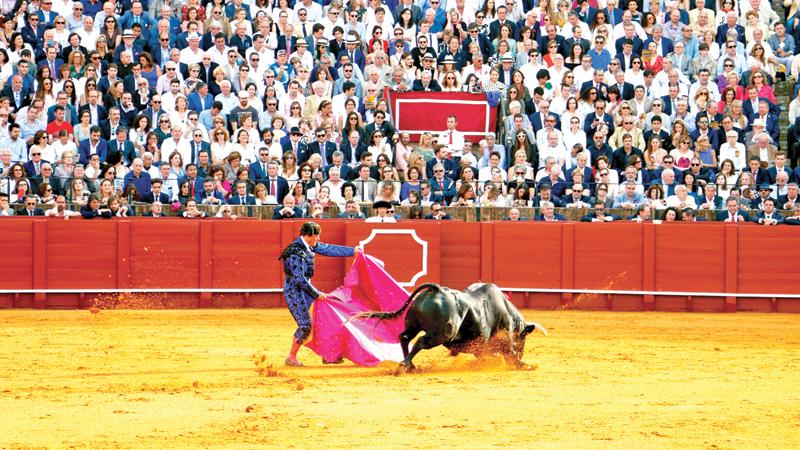
Bullfighting is the infamous tradition of fighting and killing bulls still practiced in certain hispanic countries around the world. Though it could arguably be considered a spectator sport, it is more like a ritual or show. Bullfighting is at its core very theatrical, with a massive stage, trained actors, and meticulously timed acts. To its audience, bullfighting is a well loved spectacle with a very long lived and colored history celebrated to this day.
However, outside of the countries the tradition is followed in, bullfighting is very controversial and much reviled for the inhumane torture and slaughtering of an animal for the sake of entertainment.
 Cattle and bulls have for centuries been considered a sacred animal, worshiped for the many benefits people have been able to reap from them over the centuries. And as a sacred creature, many rituals involving it have been developed in many historic and even prehistoric civilisations.
Cattle and bulls have for centuries been considered a sacred animal, worshiped for the many benefits people have been able to reap from them over the centuries. And as a sacred creature, many rituals involving it have been developed in many historic and even prehistoric civilisations.
Ancient Crete civilisations observed a non lethal equivalent to bullfighting at around 2000 BC with Bull Leaping, which involved rite practitioners leaping over bulls in a show of worship. Contemporary versions of this sport is still practiced in France and Tamil nadu regions of India. Killing bulls have been observed as important rituals in ancient Iranian civilisations.
Origins
The direct origins of the kind of bullfighting unique to Spain and other hispanic countries can be traced back to Rome and its venationes, games of hunting and killing wild animals held in amphitheaters for entertainment.
It’s been theorized that bullfighting originated from these games, as Rome’s influence spread across Europe. Another theory is of Emperor Claudius introducing bullfighting to Hispania as a substitute to gladiatorial combat which was outlawed for a time under his rule.
However, when it came to be introduced, bullfighting was a popular sport enjoyed by the wealthy classes of medieval Spain. But the sport was much less elaborate, with a single lance wielding fighter on horseback going up against a bull. Over time, bullfighting in Spain developed to what it is today, with the appropriate constructions such as dedicated bullrings being introduced.
There are many variations of bullfighting currently practiced across the world. The most well known and controversial of these is the Spanish style Bullfighting. Known locally as corrida de toros or simply la fiesta, each fight, or corrida, is split into three acts and is quite brutal.
While most depictions of bullfighting in pop culture give the idea that though it is a violent practice, the bullfighter or matador takes down the bull swiftly and in a fair competition of strength. In reality, the entire fight is drawn out, and the bull is greatly weakened by third parties.
‘Fight’
By the time the Matador takes on the bull head on, the bull is barely able to see, aggravated, tired and suffering blood loss. Though the bull is sometimes spared, that is a rare occurrence and most are killed during the ‘fight’.
According to the Humane Society International, over 250,000 bulls are killed in the thousands of bullfighting events held every year. It is still clearly a well beloved tradition in the countries where it is practiced.
But it is on the decline, falling out of favour with younger generations and due to the public out cry against its animal cruelty. Even within Spain, there are parts of the country where it is looked down upon and some regions where it doesn’t happen at all.
However, though the act of Spanish Bullfighting is clearly inhumane and cruel, the tradition does not necessarily need to be erased. Many other countries already have their own variation of bullfighting that is significantly more humane in nature, Spain may only need to adapt their traditions to suit the humane sensibilities of the modern age.
